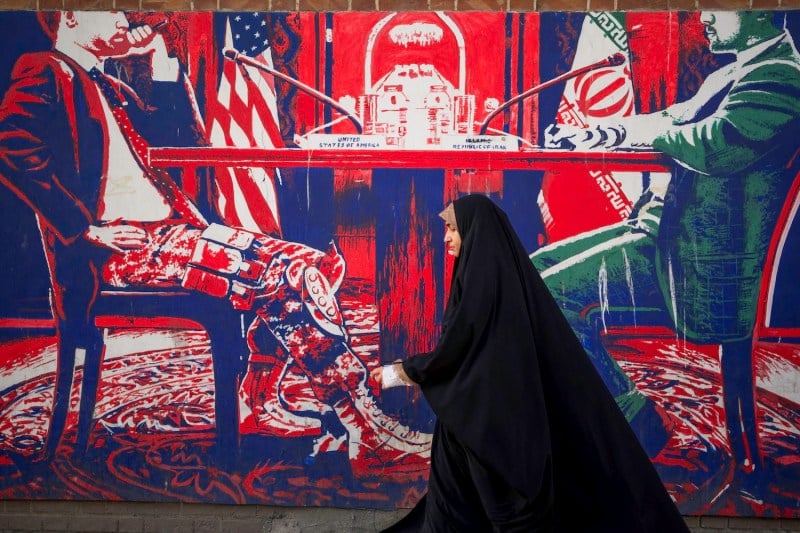How the United States Can Win the Global Tech Race

How the United States Can Win the Global Tech Race
Bans and sanctions aren’t enough to beat China.
People wear virtual reality goggles at the Hangzhou International Expo Center in the city of Hangzhou in eastern China’s Zhejiang province on June 3. STR/AFP via Getty Images
The Trump administration has scrapped its predecessor’s sweeping export controls for advanced artificial intelligence chips, known as the AI diffusion rule.
“To win the AI race, the Biden AI diffusion rule must go,” posted David Sacks, U.S. President Donald Trump’s top AI advisor, on May 8. Sacks continued his criticism at the Saudi-U.S. Investment Forum a few days later, arguing that the rule “restricted the diffusion or proliferation of American technology all over the world.”
The Trump administration has scrapped its predecessor’s sweeping export controls for advanced artificial intelligence chips, known as the AI diffusion rule.
“To win the AI race, the Biden AI diffusion rule must go,” posted David Sacks, U.S. President Donald Trump’s top AI advisor, on May 8. Sacks continued his criticism at the Saudi-U.S. Investment Forum a few days later, arguing that the rule “restricted the diffusion or proliferation of American technology all over the world.”
As the administration decides what comes next, it should raise its sights from merely proposing a “simpler” rule to manage the diffusion of AI chips. Instead, it should seize the opportunity to offer an ambitious vision to promote the broader diffusion of U.S. technology.
After all, the world not only wants the United States’ AI chips, but also its AI applications, data centers, cloud services, satellites, and advanced technology offerings generally. But even as Beijing extends its digital offerings in key emerging markets, U.S. foreign policy has failed to adapt for a global technology competition with era-defining stakes. Whether you agree with the Trump administration or not, its disruption is an opportunity to forge a new model of technology statecraft to help the United States win the race to shape strategic digital infrastructure and technology diffusion across the globe.
To start, Washington must finally learn from its failure in the transition to 4G and 5G telecommunications networks, where Beijing’s state-backed model—and the absence of a compelling U.S.-led alternative—enabled Huawei and ZTE to all but corner emerging markets. Huawei now operates in more than 170 countries worldwide and is the top global provider of telecommunications equipment. But if there is broad consensus among U.S. policymakers that Beijing won that global technology transition, there is little agreement about how to win the next.
They have little time to waste. From Brasília to New Delhi, technology has moved to the center of government ambitions to drive growth, improve governance, and modernize security. Indonesian President Prabowo Subianto views the digital sector as essential to diversifying the country’s commodity-reliant economy. Kenyan President William Ruto hopes to boost the country’s “Silicon Savannah” by accelerating cloud migration. Saudi Crown Prince Mohammed bin Salman has made AI central to his “Vision 2030” framework for the kingdom’s modernization. The result is surging global demand not only for AI data centers, but also for cutting-edge digital infrastructure, services, and skilling more broadly.
In the coming years, foreign capitals and corporate boards will make potentially generational decisions about whether to meet this demand by partnering with the United States and its allies or China. These short-term decisions could have generational consequences. Projects to lay a transcontinental submarine cable or build large-scale data centers, for instance, are mapped in decades.
Even virtual cloud and AI services can have long-term stickiness. Imagine the pain of migrating an entire ministry’s data to a new cloud provider, or switching from an AI model that has been fine-tuned with a company’s sensitive data over time. Consider Beijing’s decade-plus struggle to transition its government computers from Windows. First movers reap powerful advantages.
If the stakes are great in the current round of global technology diffusion, so is the United States’ hand. Unlike the transition to 4G and 5G networks, where Western competitors such as Ericsson and Nokia struggled to match Huawei’s and ZTE’s subsidized offerings in emerging markets, the United States enters this technology transition with formidable advantages.
The United States occupies a commanding position in AI, with leadership or leverage over every part of the stack, ranging from chip design, tooling, and fabrication to model training and testing. U.S. companies hold at least a 70 percent share of the global cloud market. In space, Starlink has launched more satellites than all its competitors combined since 2020. Below the waves, three of the top four companies deploying subsea fiberoptic cables—the internet’s backbone—are from the United States or its close allies: SubCom (U.S.), Alcatel (France), and NEC (Japan). China controls the fourth, HMN Technologies (formerly Huawei Marine), which has deployed a mere 7 percent of the world’s submarine cables.
Despite powerful advantages, U.S. success is far from assured. The lesson of the 4G and 5G race is not to mirror China’s state-driven approach or to leave the private sector to fend for itself against Chinese competitors with powerful state backing. Nor is it to rely solely on export controls and other restrictive measures, however necessary those may be. The answer is to make U.S. foreign policy fit the global technology competition.
Washington can start with reforms in three broad areas.
First, unleash the United States’ strategic investment tools. One of Washington’s most promising but underused tools is the International Development Finance Corporation (DFC). Created during the first Trump administration, the DFC makes market-driven investments to advance both humanitarian and national security goals, and it has several tools to attract private capital from equity investments to political risk insurance.
As Congress considers DFC reauthorization—its current mandate expires in September—it should raise the existing cap on its lending authority from $60 billion to at least $100 billion and make strategic technologies and digital infrastructure an explicit priority. Congress should also loosen restrictions that can block DFC from supporting digital infrastructure projects that incidentally benefit high-income countries, which has kept it from financing critical subsea cables in the Indo-Pacific that invariably have landing points in Singapore, a major interconnection hub for the region.
The Export-Import Bank (EXIM) also punches below its weight. EXIM helps level the playing firm for U.S. firms competing abroad with a $135 billion lending limit and tools such as direct loans, loan guarantees, and insurance to de-risk purchases of U.S. exports. The United States once led the world in export financing, but China now dominates. In 2022, Chinese export credit agencies provided $11 billion in export support, compared to just $2.7 billion from EXIM.
Under the first Trump administration, EXIM created a new China and Transformational Exports Program (CTEP) to prioritize investments that counter Beijing’s subsidies and support advanced technologies such as AI and semiconductors. EXIM now aims to reserve at least 20 percent of its support for the program.
Despite progress, EXIM remains plagued with issues. To receive CTEP support, at least 51 percent of the exported content must be American-made—far higher than requirements in competitor agencies. Another requirement that EXIM-supported goods travel on U.S.-flagged vessels also hinders participation. Although well-intentioned, EXIM’s mandate to create jobs can deprioritize the export of low-labor digital exports such as AI and cloud services. Compounding the problem, EXIM is also required to limit defaults across its total lending portfolio to less than 2 percent, fueling risk-aversion.
Washington should reform EXIM for the global technology competition by at least doubling the 20 percent allocation for CTEP, relaxing shipping rules, and counting some allied components toward its content requirement. Lawmakers could also loosen the mandate to support U.S. job creation for digital services and double EXIM’s default cap to encourage more risk-taking.
Second, Washington should turbocharge its commercial diplomacy for technology. Between 2016 and 2020, an average of just 900 U.S. personnel from the State and Commerce departments were deployed abroad for commercial diplomacy, and just a fraction focused on technology. Since 2022, the State Department has taken important steps by establishing a new Bureau of Cyberspace and Digital Policy, a special envoy for critical and emerging technologies, and a course on cyberspace and digital policy tradecraft.
Despite this progress, few U.S. diplomats—and even fewer ambassadors—have deep technology expertise, which means that front-line opportunities to secure key technology bids and shape emerging AI or data policies can go unnoticed or suffer from inadequate staff or substance to engage effectively.
As the administration reforms the State Department, it should reinforce the Bureau of Cyberspace and Digital Policy, which has elevated and streamlined technology diplomacy across the government; expand technology training for foreign service officers; and, more ambitiously, launch a dedicated career track within the diplomatic corps for foreign technology officers.
Two smaller and often overlooked arms of the country’s technology diplomacy are the U.S. Foreign Commercial Service and the U.S. Trade and Development Agency (USTDA). The Commercial Service is a roughly 2,200-person global network of trade specialists that helps U.S. businesses identify and navigate foreign markets. But just 225 of its staff deploy abroad across 80 countries, which means that they constantly struggle to meet demand from U.S. technology companies and foreign partners. The USTDA helps identify and mature commercial opportunities abroad to boost U.S. exports. Digital infrastructure is one of the agency’s four priority sectors, but surging interest has far outpaced current resources.
The Trump administration can turbocharge U.S. commercial diplomacy by consolidating USTDA and the Commercial Service, elevating technology and digital infrastructure as a priority, and allocating more resources and personnel.
Finally, the United States should embrace a newly ambitious vision for technology partnerships. Too often, U.S. and allied firms lose one-off bids to subsidized, politically backed Chinese competitors, even if the firms might prefer to align with the high-tech U.S. ecosystem. Washington should explore how to make such an offer without simply imitating Beijing’s state-led model.
For example, Washington could create opportunities for foreign governments to request strategic technology partnerships that match their specific needs—for example, to accelerate AI adoption in government, expand data center capacity, or improve rural connectivity with low earth orbit satellites.
Washington could lay out clear, broadly consistent criteria as a condition for these partnerships—such as robust IP and cybersecurity protections, divestment from China-linked digital infrastructure, purchase commitments for U.S. goods and services, and even investment in the United States. The Trump administration has begun to model such an approach in its recent deals with Saudi Arabia and the United Arab Emirates, but it could go even further.
If countries meet these conditions, Washington should commit not only to loosening export controls on advanced AI chips, but also to fast-tracking support from the DFC, EXIM, and USTDA; expanding technology trade missions, talent exchange programs, and research collaboration; and facilitating connections with U.S. technology firms. The United States holds the strongest hand in advanced technology and should drive a hard bargain, but it should also be generous when countries agree.
Washington can also do more to align with technology-leading allies on joint investments in strategic emerging markets. For example, Washington could better coordinate with Japan’s Overseas Development Assistance program to boost Open RAN networks across the Indo-Pacific, tap the European Union’s Global Gateway to connect subsea cables to Africa, and support India’s Digital Public Infrastructure to counter China’s “smart city” offerings.
Middle Eastern sovereign wealth funds may raise tricky strategic questions as longer-term partners, but there are other, less controversial players that Washington has yet to fully explore—such as Norway, which has both attractive conditions for AI data centers and the world’s largest sovereign wealth fund. Washington and its allies may struggle to match Beijing’s subsidies on their own, but they can easily do so together.
As the world rushes into an accelerating competition to deploy strategic technologies and digital infrastructure across the globe, the United States has almost everything it needs to prevail—world-leading companies and products, an unrivaled network of technology-leading allies, and an administration eager for reform. What Washington lacks, however, is a vision to harness these strengths in a new model of technology statecraft to help the United States win.
Vivek Chilukuri is a senior fellow and the program director of the technology and national security program at the Center for a New American Security.
Stories Readers Liked
In Case You Missed It
A selection of paywall-free articles

Four Explanatory Models for Trump’s Chaos
It’s clear that the second Trump administration is aiming for change—not inertia—in U.S. foreign policy.




















Join the Conversation
Commenting is a benefit of a Foreign Policy subscription.
Subscribe
Subscribe
Already a subscriber?
.
View Comments
Join the Conversation
Join the conversation on this and other recent Foreign Policy articles when you subscribe now.
Subscribe
Subscribe
Not your account?
View Comments
Join the Conversation
Please follow our comment guidelines, stay on topic, and be civil, courteous, and respectful of others’ beliefs.
View Comments
Change your username |
Log out
Change your username:
CANCEL
Confirm your username to get started.
The default username below has been generated using the first name and last initial on your FP subscriber account. Usernames may be updated at any time and must not contain inappropriate or offensive language.